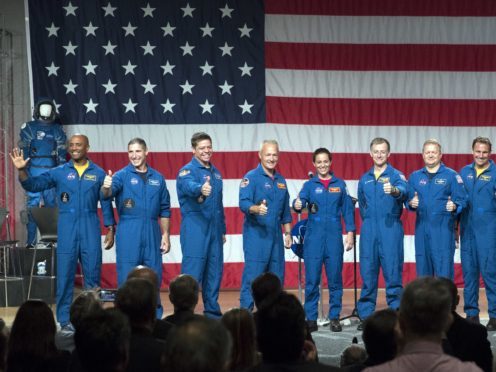Nasa has assigned the astronauts who will ride the first commercial capsules into orbit next year and bring crew launches back to the US.
SpaceX and Boeing are shooting for a test flight of their capsules by the end of this year or early next, with the first crews flying from Cape Canaveral, Florida, by next spring or summer.
Nine astronauts were named to ride the SpaceX Dragon and Boeing Starliner capsules, five on the first crew flights and four on the second round of missions to the International Space Station.
.@NASA announces the men and women who will be on board the first flights of the new spaceships built by @BoeingSpace and @SpaceX when Americans are once again launched into space from the USA. https://t.co/QuDMG2b0bO pic.twitter.com/hPNv8sx7KK
— Intl. Space Station (@Space_Station) August 3, 2018
“For the first time since 2011, we are on the brink of launching American astronauts on American rockets from American soil,” said Nasa administrator Jim Bridenstine, who made the introductions at Johnson Space Centre.
US astronauts now take Russian capsules to the space station, with Nasa paying as much as 82 million dollars a seat.
Thanks for the opportunity to fly again, @BoeingCEO. I'm honored to represent the entire #Boeing team and our commitment to the future of human space exploration. pic.twitter.com/OjHQlelO9e
— Christopher Ferguson (@Astro_Ferg) August 3, 2018
Boeing’s first Starliner crew will include a former Nasa astronaut who commanded the last shuttle flight in 2011, Chris Ferguson, who is now a Boeing employee.
The other commercial crew members are still with Nasa and all have a military background.
The seven men and two women pumped their fists in the air and gave thumbs-up as they strode onto the stage to cheers from the crowd.
“As a test pilot, it doesn’t get any better than this,” said astronaut Nicole Aunapu Mann, a Naval aviator who will make her first trip into space on the first Starliner crew.
With today's @Commercial_Crew announcement, we are on the brink of launching American astronauts on American rockets from American soil. Congratulations to the entire class of astronauts that were announced today. You are all American heroes. #LaunchAmerica pic.twitter.com/LJfuTPHJ9u
— Jim Bridenstine (@JimBridenstine) August 3, 2018
Nasa has been paying billions of dollars to SpaceX and Boeing to develop the crew capsules to pick up where the shuttles left off, while also paying billions for cargo deliveries to the space station by SpaceX and Northrop Grumman.
The cargo missions started in 2012.
The crew missions have been delayed repeatedly because of the technical challenges and difficulties of making spacecraft safe for humans.

A recent abort test by Boeing resulted in leaking engine fuel.
Astronaut Doug Hurley, who will be on the first crew of the SpaceX Dragon, hinted at the delays when he noted: “The first flight is something you dream about as a test pilot, and you don’t think it’s ever going to happen to you. But looks like it might.”
“Oh, it better,” Mr Bridenstine chimed in.
Besides Mr Ferguson and Ms Mann, the initial commercial crew members are: Eric Boe, Sunita Williams and John Cassada riding on Boeing.
Robert Behnken, Douglas Hurley, Victor Glover and Michael Hopkins will fly with SpaceX.
Meet the first four @NASA astronauts who will fly aboard Crew Dragon to the @Space_Station! https://t.co/9JZLWOPSK0 pic.twitter.com/mNYa1PjKwU
— SpaceX (@SpaceX) August 3, 2018
SpaceX President Gwynne Shotwell took a photo of the astronauts before assuring them: “We won’t let you down.”
Boeing’s Starliners will soar on United Launch Alliance’s Atlas V rockets.
Dragons, meanwhile, will fly on SpaceX’s own Falcon 9 rockets.
The race to get astronauts to the space station first is real; a US flag that flew on the first space shuttle flight in 1981 and the last shuttle flight in 2011, awaits the winner.
A white SpaceX launch suit and a blue Boeing launch suit stood on display behind the astronauts on stage.
Congratulations @Astro_Ferg and team on being named as Commercial Crew astronauts! You’re now free to move about the solar system. 🚀 pic.twitter.com/A7TWX272hK
— The Boeing Company (@Boeing) August 3, 2018
Mr Ferguson told the gathering that these new high-tech capsules will have a higher emphasis on safety than the shuttle did, with full abort systems.
The group likened it to flying an iPhone, with a minimal number of switches compared with the 3,000 switches in the old shuttle cockpit.
As for being the only non-Nasa person on board, Mr Ferguson explained later during a Reddit Ask Me Anything programme that Boeing always uses company test pilots for first flights “and the Starliner is no exception”.
Flying on the first crewed test flight of @BoeingSpace’s #Starliner spacecraft will be @Astro_Boe, @AstroDuke & @Astro_Ferg. After liftoff from @NASAKennedy in mid-2019, the trio will dock & undock autonomously to @Space_Station before returning to Earth: https://t.co/KurQccWAS0 pic.twitter.com/YdQazHF2jo
— NASA (@NASA) August 3, 2018
The first regular mission of @BoeingSpace’s #Starliner spacecraft will carry @Astro_Josh & @Astro_Suni to @Space_Station where they will live and work for the duration of their mission before returning safely to Earth: https://t.co/oD5emo7y8q pic.twitter.com/kH3nJTJSMW
— NASA (@NASA) August 3, 2018
SpaceX is shooting for a test flight without passengers in November and a crew flight in April.
Boeing is aiming for a test flight at the end of this year or early next, and the first crew flight in the middle of next year.
By handing off crew and cargo runs to the space station, which will keep orbiting until at least 2024, Nasa has set its sight on the moon and Mars, developing the Orion capsule and the massive Space Launch System rocket.
“This is truly an exciting time for human spaceflight in our nation, and believe me, it’s only going to get better as we charge off into the future,” said Bob Cabana, a former shuttle commander who now heads Kennedy Space Centre.
